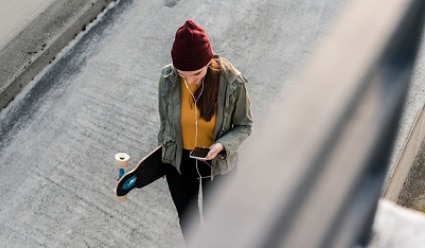Spotify rocks advertisers with measurement by Oracle
With over 200 million listeners on its ad-supported service, Spotify uses Oracle Moat to prove the value of video ads on the music and podcast platform.
Video ads on an audio platform
Spotify doesn’t have users, it has true believers—fans who use the streaming music platform to soundtrack their lives, whether they’re driving to work or mowing the lawn, and whether they groove to Dua Lipa or headbang to Metallica.
There’s a Spotify playlist for every moment, with names like “Songs to Sing in the Shower” and “Beast Mode,” pulled from one of the world’s largest music collections. Listeners can also tune into an exploding array of podcasts.
No wonder Spotify has more than 381 million monthly active users in 178 countries

With over 200 million listeners on the free, ad-supported service, Spotify’s advertising is surging. And those impressions don’t come from just audio ads but video as well—something that might not be top of mind when you think about an audio platform.
“Video is a tried-and-true format across digital advertising,” says Katie Oakes, Spotify senior product marketing manager. “We knew that our advertising clients would appreciate the chance to share their visual messages with Spotify listeners in the moments they are looking at the screen.”
When Spotify introduced video ads in 2014, the company knew advertisers might be skeptical of video on a digital audio platform, so it needed proof that the ads reached the right audiences. Besides being expensive to create, video ads are easily missed on today’s busy websites. To show that Spotify offered a better context for connecting with buyers, ad measurement would be critical.
“Advertisers want high-impact opportunities to reach their target audiences,” says Rochelle Sanchirico, Spotify global director of SMB marketing. “At Spotify, we’re always looking for new ways to connect them to very engaged consumers.”
Oracle Moat proves engagement
To expand measurement options, Spotify in 2016 rolled out Oracle Moat Analytics, a cloud-based suite that helps advertisers, publishers, and platform owners measure ad performance across digital and TV campaigns.
“Spotify chose Moat because it was a leader in the video measurement space,” Sanchirico says. “We always want to provide a first-class experience for our listeners and advertisers. Moat was a great fit, and it still is.”

With Moat, advertisers know that Spotify outperforms. In viewability—valid impressions that are viewed for at least a couple of seconds—Spotify scores 21.5% higher than the industry benchmark. And in completion quality, a metric showing if users see and hear completed ads, the platform ranks 130.1% higher.
On other platforms, people often view video ads with the sound off. Because Spotify is an audio platform, users keep the sound on. What’s more, Spotify serves video ads only when users are “in focus”—meaning looking at the app, such as when they’re browsing the catalog for songs or podcasts.
All of this is music to advertisers’ ears. “Having sound-on, in-focus ads is a key part of our value proposition,” says Sanchirico. Advertisers can tell a more nuanced story when they have the attention of their audiences’ eyes and ears. “We can prove the value of running video ads on Spotify,” she says.
And that’s a good thing: the industry’s mega-players, advertising holding companies, wouldn’t think of placing ads without measurement capability. “With Moat we can say, ‘Hey, not only do we have this super-viewable unit, but we can show you the numbers,” says Oakes.
‘In the moment’ ads
Spotify has continued evolving its video ad options. Its advertising platform Spotify Ad Studio, a self-serve option, offers access to small and medium businesses that take more of a DIY marketing approach.
Ad Studio provides simple tools for ad targeting, creation, and measurement so that thousands of SMBs—most too small to hire an agency—can connect with audiences in the moment, Sanchirico says.
“We strive to provide an experience that’s immersive and feels authentic,” Sanchirico says. “We really work with our advertisers to create messages that make sense in context,” whether it’s a music playlist or a true-crime podcast.
For example, if you’re listening to the “Ultimate Baking Playlist,” odds are you’ll be more receptive to an ad for a bakeware set, as you smell the snickerdoodles you just popped in the oven.
Spotify invests heavily in discovering artists and podcasters and in helping them find their audiences. Advertisers, of course, want to reach the right audiences at scale. To stay competitive, Spotify is always exploring new ways to help them do that.
Ads on Spotify podcasts illustrate the point. Historically, podcast buying was one-to-one, with advertisers purchasing ads on a specific podcast. Now Spotify lets them choose their audiences—telling them where those people are and what they’re listening to, so brands can both target carefully and expand audience size.
“As we move forward, we’ll always seek opportunities for our advertisers’ messages to be seen and heard in context,” Sanchirico says. “And measurement will be important. That’s how we see Moat helping us in our journey.”